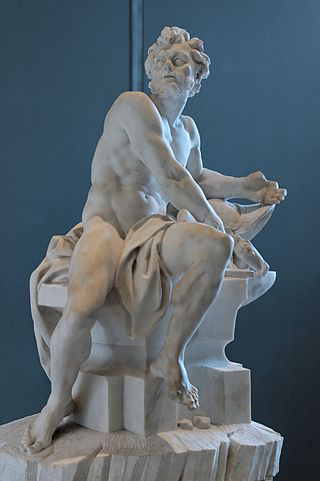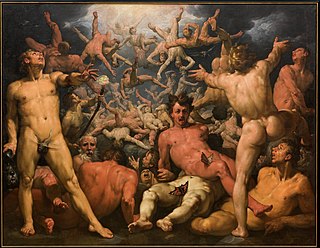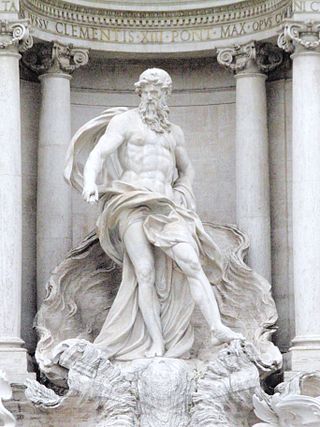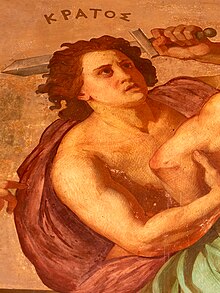
Hephaestus is the Greek god of artisans, blacksmiths, carpenters, craftsmen, fire, metallurgy, metalworking, sculpture and volcanoes. Hephaestus's Roman counterpart is Vulcan. In Greek mythology, Hephaestus was either the son of Zeus and Hera or he was Hera's parthenogenous child. He was cast off Mount Olympus by his mother Hera because of his lameness, the result of a congenital impairment; or in another account, by Zeus for protecting Hera from his advances.

In Greek mythology, Prometheus is one of the Titans and a god of fire. Prometheus is best known for defying the Olympian gods by stealing fire from them and giving it to humanity in the form of technology, knowledge, and more generally, civilization.

In Greek mythology, Styx, also called the River Styx, is a goddess and river of the Underworld. Her parents were the Titans Oceanus and Tethys, and she was the wife of the Titan Pallas, and the mother of Zelus, Nike, Kratos, and Bia. She sided with Zeus in his war against the Titans, and because of this, to honor her, Zeus decreed that the solemn oaths of the gods be sworn by the water of Styx.

The Theogony is a poem by Hesiod describing the origins and genealogies of the Greek gods, composed c. 730–700 BC. It is written in the Epic dialect of Ancient Greek and contains 1022 lines.

Zeus is the sky and thunder god in ancient Greek religion and mythology, who rules as king of the gods on Mount Olympus. His name is cognate with the first syllable of his Roman equivalent Jupiter.

In Greek mythology, the Titans were the pre-Olympian gods. According to the Theogony of Hesiod, they were the twelve children of the primordial parents Uranus (Sky) and Gaia (Earth), with six male Titans—Oceanus, Coeus, Crius, Hyperion, Iapetus, and Cronus—and six female Titans, called the Titanides or Titanesses—Theia, Rhea, Themis, Mnemosyne, Phoebe, and Tethys. Cronus mated with his older sister Rhea, who then bore the first generation of Olympians: the six siblings Zeus, Hades, Poseidon, Hestia, Demeter, and Hera. Certain descendants of the Titans, such as Prometheus, Atlas, Helios, and Leto, are sometimes also called Titans.

In Greek mythology, Oceanus was a Titan son of Uranus and Gaia, the husband of his sister the Titan Tethys, and the father of the river gods and the Oceanids, as well as being the great river which encircled the entire world.

In Greek mythology, Tartarus is the deep abyss that is used as a dungeon of torment and suffering for the wicked and as the prison for the Titans. Tartarus is the place where, according to Plato's Gorgias, souls are judged after death and where the wicked received divine punishment. Tartarus appears in early Greek cosmology, such as in Hesiod's Theogony, where the personified Tartarus is described as one of the earliest beings to exist, alongside Chaos and Gaia (Earth).

In Greek mythology and religion, Themis is the goddess and personification of justice, divine order, law, and custom. She is one of the twelve Titan children of Gaia and Uranus, and the second wife of Zeus. She is associated with oracles and prophecies, including the Oracle of Delphi. Her symbol is the Scales of Justice.

In Greek mythology, Bia is the personification of force. According to the preface to Fabulae by Gaius Julius Hyginus, Bia's Roman name was Vis.

In Greek mythology, the Oceanids or Oceanides are the nymphs who were the three thousand daughters of the Titans Oceanus and Tethys.
In Greek mythology, Zelus or Zelos was the daimon that personifies dedication, emulation, eager rivalry, envy, jealousy, and zeal. The English word "zeal" is derived from his name.

The Gorgons, in Greek mythology, are three female monsters, Stheno, Euryale, and Medusa, sisters who were able to turn anyone who looked at them to stone. Euryale and Stheno were immortal, but Medusa was not and was slain by the hero Perseus.

Typhon, also Typhoeus, Typhaon or Typhos, was a monstrous serpentine giant and one of the deadliest creatures in Greek mythology. According to Hesiod, Typhon was the son of Gaia and Tartarus. However, one source has Typhon as the son of Hera alone, while another makes Typhon the offspring of Cronus. Typhon and his mate Echidna were the progenitors of many famous monsters.

In Greek mythology, Tethys was a Titan daughter of Uranus and Gaia, a sister and wife of the Titan Oceanus, and the mother of the river gods and the Oceanids. Although Tethys had no active role in Greek mythology and no established cults, she was depicted in mosaics decorating baths, pools, and triclinia in the Greek East, particularly in Antioch and its suburbs, either alone or with Oceanus.

In Greek mythology, Epimetheus is the twin brother of Prometheus, the pair serving "as representatives of mankind". Both sons of the Titan Iapetus, while Prometheus ("foresight") is ingeniously clever, Epimetheus ("hindsight") is inept and foolish. In some accounts of the myth, Epimetheus unleashes the unforeseen troubles in Pandora's box.

Prometheus Bound is an ancient Greek tragedy traditionally attributed to Aeschylus and thought to have been composed sometime between 479 BC and the terminus ante quem of 424 BC. The tragedy is based on the myth of Prometheus, a Titan who defies Zeus, and protects and gives fire to mankind, for which he is subjected to the wrath of Zeus and punished.

In ancient Greek religion and mythology, Phoebe was one of the first generation of Titans, who were one set of sons and daughters of Uranus and Gaia. She was the grandmother of Apollo and Artemis, and the witchcraft goddess Hecate. According to myth, she was the original owner of the site of the Oracle of Delphi before gifting it to her grandson Apollo. Her name, meaning "bright", was also given to a number of lunar goddesses like Artemis and later the Roman goddesses Luna and Diana, but Phoebe herself was not actively treated as a moon goddess in her own right in ancient mythology.
The Prometheia is a trilogy of plays about the Titan Prometheus. It was attributed in Antiquity to the 5th-century BC Greek tragedian Aeschylus. Though an Alexandrian catalogue of Aeschylean play titles designates the trilogy Hoi Prometheis, in modern scholarship the trilogy has been designated the Prometheia to mirror the title of Aeschylus' only extant trilogy, the Oresteia. Unlike the Oresteia, only one play from this trilogy—Prometheus Bound—survives. Inasmuch as the authorship of Prometheus Bound continues to be debated, the very existence of a Prometheus trilogy is uncertain. To the extent that modern scholars postulate the existence of such a trilogy by a single author, the consensus holds that it comprised Prometheus Bound, Prometheus Unbound, and Prometheus the Fire-Bringer, in that order.
In Greek mythology, Clymene or Klymene is the name of one of the three thousand Oceanid nymphs, usually the wife of Iapetus and mother by him of Prometheus, Epimetheus, Atlas and Menoetius.






















